-
Table of Contents
- Introduction
- Exploring the Wonders of the World: Visiting the Most Famous Landmarks
- A Guide to Visiting the Most Iconic Structures and Monuments
- Exploring the History Behind Famous Landmarks
- The Best Time to Visit Famous Landmarks
- The Benefits of Visiting Famous Landmarks: A Look at the Educational and Cultural Impact
- Conclusion
Await!
Introduction
Visiting famous landmarks is a great way to explore the world and learn about its history. From iconic structures and monuments to natural wonders, there are so many amazing places to visit. Whether you’re looking for a cultural experience or a chance to take in some breathtaking views, there’s something for everyone. From the Eiffel Tower in Paris to the Great Wall of China, these landmarks are sure to leave you with lasting memories. So, if you’re looking for a unique way to explore the world, why not start with some of the most famous landmarks?
Exploring the Wonders of the World: Visiting the Most Famous Landmarks

Exploring the Wonders of the World is an exciting and rewarding experience. From the Great Wall of China to the Taj Mahal, there are many famous landmarks around the world that are worth visiting. In this blog post, we’ll take a look at some of the most iconic and awe-inspiring landmarks that you should consider adding to your travel bucket list.
The Great Wall of China is one of the most iconic landmarks in the world. This ancient structure stretches for more than 5,500 miles and is a testament to the ingenuity of the Chinese people. Visiting the Great Wall is a must-do for any traveler, as it offers stunning views and a unique insight into Chinese history.
The Taj Mahal is another iconic landmark that is worth visiting. Located in Agra, India, this stunning white marble mausoleum was built by Mughal emperor Shah Jahan in memory of his beloved wife. The Taj Mahal is a symbol of love and devotion, and it is one of the most beautiful buildings in the world.
The Eiffel Tower is one of the most recognizable landmarks in the world. Located in Paris, France, this iconic structure was built in 1889 and stands at a height of 1,063 feet. Visiting the Eiffel Tower is a must-do for any traveler, as it offers stunning views of the city and a unique insight into French culture.
The Colosseum in Rome, Italy is another iconic landmark that is worth visiting. This ancient amphitheater was built in 80 AD and is a testament to the power and grandeur of the Roman Empire. Visiting the Colosseum is a must-do for any traveler, as it offers a unique insight into Roman history and culture.
The Statue of Liberty is one of the most iconic landmarks in the world. Located in New York City, this iconic statue was a gift from France to the United States and is a symbol of freedom and democracy. Visiting the Statue of Liberty is a must-do for any traveler, as it offers stunning views of the city and a unique insight into American history.
Exploring the Wonders of the World is an exciting and rewarding experience. From the Great Wall of China to the Statue of Liberty, there are many iconic landmarks around the world that are worth visiting. Whether you’re looking for a unique insight into history or simply want to take in the beauty of these iconic structures, these landmarks are sure to leave a lasting impression.
A Guide to Visiting the Most Iconic Structures and Monuments
From the Great Wall of China to the Taj Mahal, the world is full of iconic structures and monuments that have stood the test of time. Whether you’re a history buff or a traveler looking for a unique experience, visiting these iconic sites is a must. Here’s a guide to some of the most iconic structures and monuments around the world.
The Great Wall of China
The Great Wall of China is one of the most iconic structures in the world. Built over 2,000 years ago, the wall stretches for more than 5,500 miles and is a testament to the ingenuity of the Chinese people. Visiting the Great Wall is an unforgettable experience, and there are several sections of the wall that are open to the public.
The Taj Mahal
The Taj Mahal is one of the most iconic monuments in the world. Located in Agra, India, the Taj Mahal was built in the 17th century by the Mughal emperor Shah Jahan as a tribute to his beloved wife. The Taj Mahal is a stunning example of Mughal architecture, and it’s a must-see for any traveler.
The Eiffel Tower
The Eiffel Tower is one of the most iconic structures in the world. Located in Paris, France, the Eiffel Tower was built in 1889 and stands at 1,063 feet tall. Visiting the Eiffel Tower is a must for any traveler, and there are several ways to experience the tower, including taking the elevator to the top or taking a guided tour.
The Colosseum
The Colosseum is one of the most iconic monuments in the world. Located in Rome, Italy, the Colosseum was built in the 1st century AD and was used for gladiator fights and other public spectacles. Visiting the Colosseum is a must for any traveler, and there are several ways to experience the monument, including taking a guided tour or exploring the ruins on your own.
The Statue of Liberty
The Statue of Liberty is one of the most iconic monuments in the world. Located in New York City, the Statue of Liberty was a gift from France to the United States in 1886 and stands at 305 feet tall. Visiting the Statue of Liberty is a must for any traveler, and there are several ways to experience the monument, including taking a ferry to Liberty Island or taking a guided tour.
These are just a few of the most iconic structures and monuments around the world. Visiting these sites is a great way to experience history and culture, and it’s an experience you won’t soon forget.
Exploring the History Behind Famous Landmarks
From the Great Wall of China to the Eiffel Tower, the world is full of iconic landmarks that have become symbols of their respective countries. But what is the history behind these famous landmarks? In this blog post, we’ll explore the stories behind some of the world’s most famous landmarks.
The Great Wall of China is one of the most iconic landmarks in the world. It was built over 2,000 years ago to protect the Chinese Empire from invaders. The wall was constructed by millions of laborers over the course of centuries, and it stretches for more than 5,500 miles. Today, it is a popular tourist destination and a symbol of Chinese culture.
The Eiffel Tower is another iconic landmark. It was built in 1889 for the World’s Fair in Paris. The tower was designed by Gustave Eiffel and stands at 1,063 feet tall. It is one of the most recognizable structures in the world and is a symbol of French culture.
The Taj Mahal is a stunning white marble mausoleum located in Agra, India. It was built by Mughal emperor Shah Jahan in memory of his beloved wife, Mumtaz Mahal. The Taj Mahal is considered one of the most beautiful buildings in the world and is a symbol of love and devotion.
The Statue of Liberty is a symbol of freedom and democracy. It was a gift from France to the United States in 1886 and stands at 305 feet tall. The statue is a reminder of the ideals of freedom and justice that the United States was founded upon.
These are just a few of the many famous landmarks around the world. Each one has its own unique history and story to tell. From the Great Wall of China to the Statue of Liberty, these landmarks are reminders of our shared history and culture.
The Best Time to Visit Famous Landmarks
When it comes to visiting famous landmarks, timing is everything. Whether you’re looking to avoid the crowds or take advantage of special events, knowing the best time to visit can make all the difference. Here are some tips for getting the most out of your landmark visits.
The Eiffel Tower: The Eiffel Tower is one of the most iconic landmarks in the world. The best time to visit is in the early morning or late evening, when the crowds are smaller and the views are spectacular. If you’re looking for a special event, the tower is lit up with thousands of twinkling lights every night from sunset to 1am.
The Taj Mahal: The Taj Mahal is one of the most beautiful landmarks in the world. The best time to visit is in the early morning, when the sun is rising and the crowds are smaller. If you’re looking for a special event, the Taj Mahal is lit up with thousands of twinkling lights every night from sunset to 1am.
The Great Wall of China: The Great Wall of China is one of the most impressive landmarks in the world. The best time to visit is in the early morning or late afternoon, when the crowds are smaller and the views are spectacular. If you’re looking for a special event, the wall is lit up with thousands of twinkling lights every night from sunset to 1am.
The Colosseum: The Colosseum is one of the most iconic landmarks in the world. The best time to visit is in the early morning or late afternoon, when the crowds are smaller and the views are spectacular. If you’re looking for a special event, the Colosseum is lit up with thousands of twinkling lights every night from sunset to 1am.
No matter which landmark you’re visiting, timing is key. By visiting during the early morning or late afternoon, you’ll be able to avoid the crowds and take advantage of the best views. If you’re looking for a special event, many of the world’s most famous landmarks are lit up with thousands of twinkling lights every night from sunset to 1am. With a little planning, you can make the most of your landmark visits.
The Benefits of Visiting Famous Landmarks: A Look at the Educational and Cultural Impact
Visiting famous landmarks is an experience that can have a lasting impact on travelers. Not only do these sites offer a unique opportunity to explore the history and culture of a place, but they can also provide an educational experience that can be beneficial for both adults and children. Here, we’ll take a look at some of the benefits of visiting famous landmarks and how they can have a positive impact on travelers.
One of the most obvious benefits of visiting famous landmarks is the educational opportunities they provide. By visiting these sites, travelers can gain a better understanding of the history and culture of a place. For example, a visit to the Great Wall of China can provide insight into the country’s long history and its importance in the world today. Similarly, a visit to the Taj Mahal in India can provide an understanding of the country’s rich cultural heritage.
In addition to the educational benefits, visiting famous landmarks can also provide a unique cultural experience. By visiting these sites, travelers can gain a better understanding of the customs and traditions of a place. For example, a visit to the Eiffel Tower in Paris can provide an understanding of the city’s unique culture and its importance in the world today. Similarly, a visit to the Acropolis in Athens can provide insight into the country’s ancient history and its influence on modern culture.
Finally, visiting famous landmarks can also provide a unique opportunity to explore the natural beauty of a place. By visiting these sites, travelers can gain a better appreciation for the beauty of a place and its importance in the world today. For example, a visit to the Grand Canyon in the United States can provide an understanding of the country’s natural beauty and its importance in the world today. Similarly, a visit to the Great Barrier Reef in Australia can provide insight into the country’s unique marine life and its importance in the world today.
Overall, visiting famous landmarks can provide a unique opportunity to explore the history, culture, and natural beauty of a place. By visiting these sites, travelers can gain a better understanding of the importance of a place in the world today and its impact on the world’s culture and history. As such, visiting famous landmarks can be a beneficial experience for both adults and children alike.
Conclusion
Visiting famous landmarks is a great way to experience the history and culture of a place. Iconic structures and monuments are often the most recognizable symbols of a city or country, and they can provide a unique insight into the past. Whether it’s the Eiffel Tower in Paris, the Great Wall of China, or the Statue of Liberty in New York City, these landmarks are sure to leave a lasting impression. Visiting these landmarks can be a great way to learn more about the history and culture of a place, and to create lasting memories.















